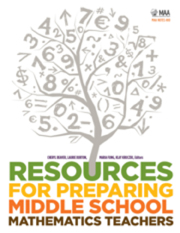Book contents
- Frontmatter
- Preface
- Contents
- I Programs for Middle School Teachers
- B In-service Training Programs
- II Courses for Middle School Teachers
- B Geometry
- C Number Theory and Abstract Algebra
- D Precalculus and Calculus
- 12 Vertically Connecting Precalculus and Calculus with Middle School Mathematics
- 13 Visual College Algebra for Teachers
- E Probability and Statistics
- F Combination Courses
13 - Visual College Algebra for Teachers
from D - Precalculus and Calculus
- Frontmatter
- Preface
- Contents
- I Programs for Middle School Teachers
- B In-service Training Programs
- II Courses for Middle School Teachers
- B Geometry
- C Number Theory and Abstract Algebra
- D Precalculus and Calculus
- 12 Vertically Connecting Precalculus and Calculus with Middle School Mathematics
- 13 Visual College Algebra for Teachers
- E Probability and Statistics
- F Combination Courses
Summary
At Western Oregon University, we offer a College Algebra for Teachers course using the Visual Algebra for College Students [3] materials that we wrote and class tested. Visual Algebra is designed to help middle school teachers gain a deep understanding of basic algebraic skills. Students visually show algebra using a concrete model (algebra pieces), verbally describe the meaning of each algebra piece move, symbolically connect the ideas to standard algebraic algorithms and procedures, and graphically connect the ideas of the visual models and symbolic work. Overall, students think deeply about topics, do not rely on rote memorization or rote rules, and understand ideas so well that they can easily describe, model, and teach core algebraic ideas to their middle grade students in a variety of ways. This allows our future teachers to meet the needs of the different learning styles in their classrooms.
Visual Algebra takes students through modeling integer operations with black and red tiles to modeling linear and quadratic patterns with tiles and variable algebra pieces, looking at the general forms of the patterns and then connecting all the ideas to symbolic manipulation, creating data sets, graphing, and finding intercepts and points of intersection. Ideas are then extended to higher order polynomial functions and then to modeling complex number operations with black, red, yellow, and green tiles. Throughout the course, students are able to relate what they learned using visual methods to the standard methods and algorithms they will see every day in their classroom. For example, after factoring quadratic equations using visual methods, students learn factoring by grouping and factoring using the “ac” method.
- Type
- Chapter
- Information
- Resources for Preparing Middle School Mathematics Teachers , pp. 143 - 154Publisher: Mathematical Association of AmericaPrint publication year: 2013

